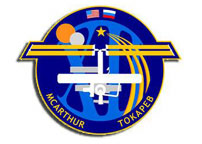NASA Space Station Status Report 17 February 2006

The International Space Station crew members completed a semiannual treadmill overhaul this week and began readying for a first-ever station "camp out" planned next week.
Expedition 12 Commander Bill McArthur and Flight Engineer Valery Tokarev spent several days replacing worn components on the treadmill. They inspected and cleaned others. The device, called the Treadmill Vibration Isolation System, floats in a pit in the floor of the station’s Zvezda living quarters module. A complex system prevents the crew’s running from shaking the station’s structure and experiments.
Following a final test run and inspection on Wednesday, the crew was given a go to return to normal use of the treadmill. It is one of several exercise options available aboard the station. Other equipment includes a stationary bicycle and a resistive exercise device that uses tension to simulate weights. Exercise is important to counteract the physical effects of long durations in weightlessness.
A special activity is planned next week to test procedures that could shorten the preparation time required in future spacewalks. The crew and Mission Control refer to this as a "camp out" since McArthur and Tokarev will shut themselves in the Quest Airlock overnight.
They will lower the air pressure to 10.2 pounds per square inch (psi), a pressure equal to about 10,000 feet high on Earth. The station is kept at 14.7 psi, near sea-level pressure.
Spending the night at the lower air pressure helps flush nitrogen from the body faster, preventing decompression sickness, commonly called "the bends." The new procedure can reduce the amount of time spacewalkers must breathe pure oxygen before a spacewalk to complete that purge.
For the test, McArthur and Tokarev will follow many of the same measures as if they were to perform a spacewalk, but they will not don their spacesuits. McArthur and Tokarev are set to enter the airlock around the start of their sleep period Thursday afternoon, Feb. 23. They will return to the main station modules when they awaken early Friday morning, Feb. 24.
In preparation for the camp out, McArthur worked in the Destiny Laboratory to replace a faulty component in a device that can measure the composition of the station’s air. On Thursday, he installed a new spectrometer in the device, called the Mass Constituent Analyzer. An attempt by Mission Control to power up the unit early Friday was unsuccessful, and McArthur was asked to do further troubleshooting. Engineers suspect the problem may be electrical connectors within the device that are not seating properly. They are continuing to analyze the problem, and McArthur may conduct further troubleshooting this weekend.
In science work this week, the EarthKAM experiment completed its most recent session on Saturday. EarthKAM uses a camera to take photos of Earth through the station window as selected by school students.
A total of 118 schools and more than 1,900 students participated in the most recent session. Schools participated from: the United States, Canada, Argentina, Germany, Spain, the United Kingdom, Belgium, Japan, and, for the first time, New Zealand. More than 1,900 images were taken and will be used in a wide-range of studies, including coastline erosion, deforestation and environmental impacts. To date, almost 1,000 schools have participated in EarthKAM with students taking nearly 20,000 photos.
For more information about EarthKAM and to view images, visit:
For information about crew activities, future launch dates and station sighting opportunities, visit:
The next station status report will be issued Friday, Feb. 24, or earlier if events warrant.








